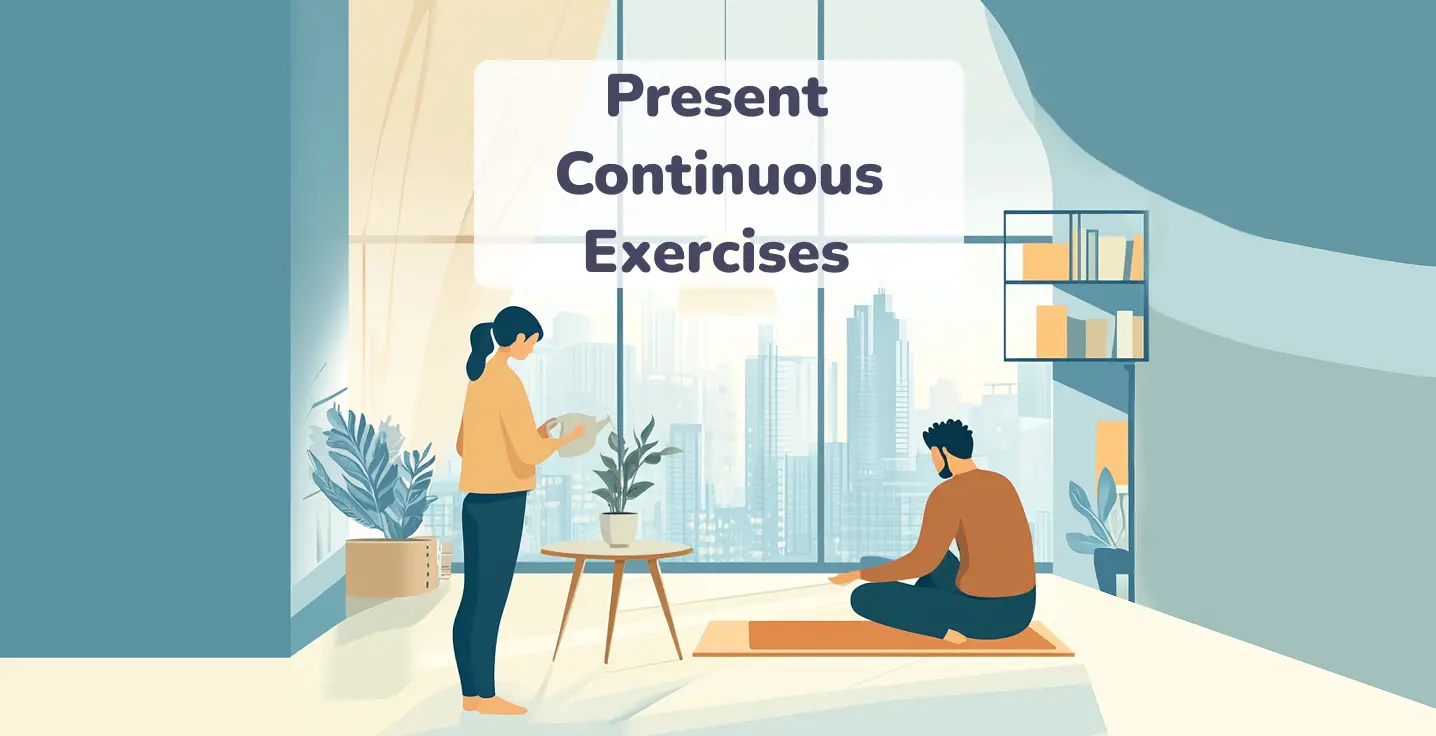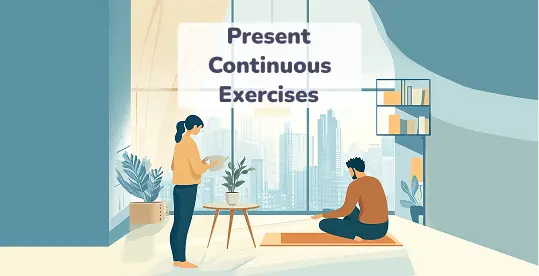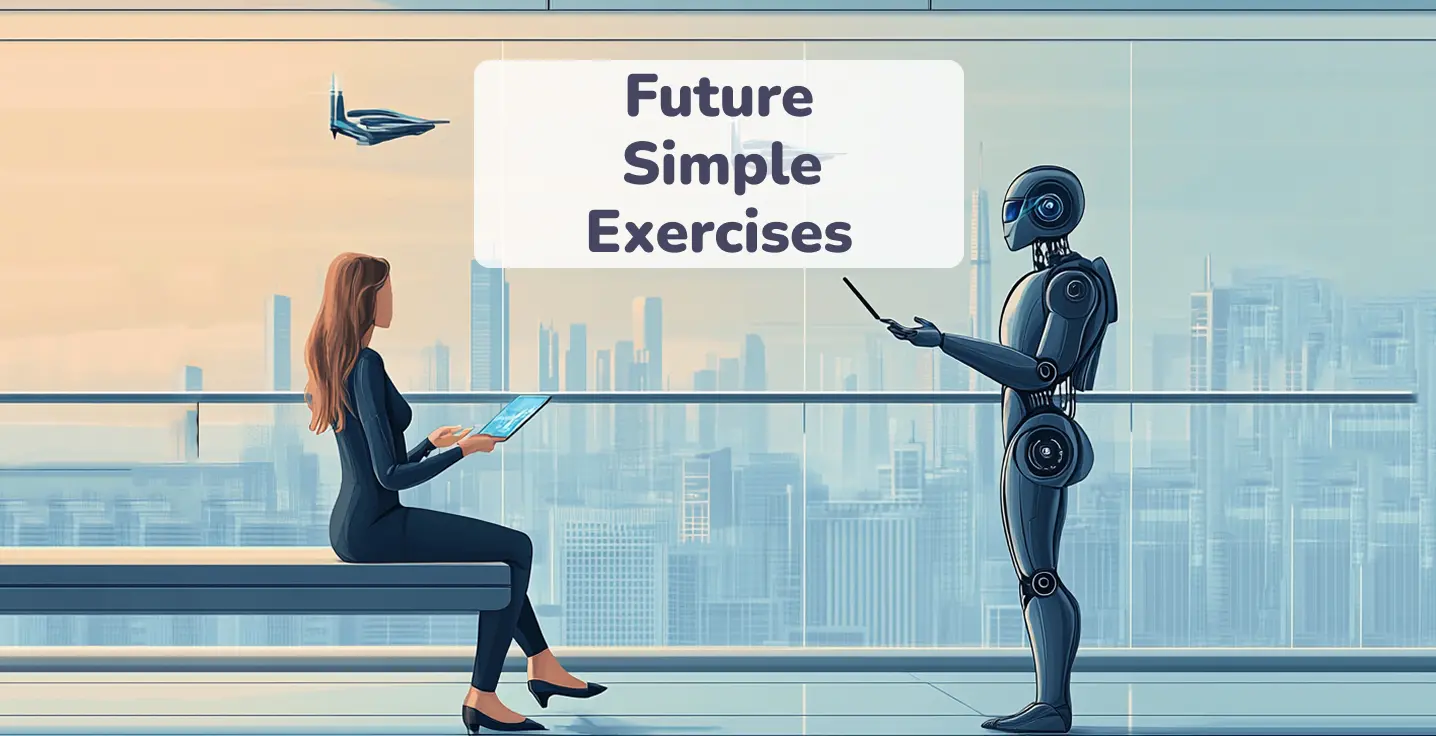Present Continuous exercises
What are the best Present Continuous tense exercises?
The trick to getting the most out of your grammar sessions for learning English is selecting the appropriate resources. Present Continuous tense activities work best when they’re fast, hands-on, and focused on how people actually speak. Below, you’ll find top-rated Present Continuous exercises with answers that tick all the boxes.
-
Fill in the blanks (short dialogues). This Present Continuous tense exercise is ideal for learning sentence structure while practicing realistic conversations. You’ll not only focus on verb forms but also catch on to natural time expressions and flow.
Here’s a simple example you might come across:
A: What ___ you ___ (do) right now?
B: I ___ (make) a sandwich.
It’s a perfect way to reinforce positive forms, questions, and context-based vocabulary. You also start spotting time clues like right now, at the moment, or currently — all markers of Present Continuous.
-
Multiple choice. A classic method for a reason. Such Present Continuous exercise trains your attention to detail and helps you choose the correct verb form using grammar logic and time references. Take this one:
Choose the correct option:
Look! She ___ to someone on the phone.
a) talks
b) talk
c) is talking
d) talkedYou’ll quickly get used to spotting when the continuous form is appropriate and avoid mixing it up with other tenses.
-
Yes/No sentences. Yes/No Present Continuous tense exercises with answers make you more comfortable switching between forms and reacting fast in spoken English. They’re especially helpful when dealing with practices in listening and speaking. For example:
Q: Are you watching that new series tonight?A: Yes, I am / No, I am not.These drills are simple but powerful—they push you to respond quickly and naturally using Present Continuous structures.
-
Word order correction. Present Continuous can look tricky at first, especially with questions. Rearranging jumbled words helps lock in the right sentence flow. Like this:
Arrange the words:
is / she / piano / playing / the
Correct answer:
Sheis playing the piano.
This style of assignments helps you internalize sentence patterns: positive, negative, and interrogative, without memorizing rules blindly.
What’s included in a standard Present Continuous test?
The format of a Present Continuous tense test usually reflects what you’re aiming to improve using Koto English — accuracy, fluency, or speed. Most often, you’ll be working with short tasks that focus on context, structure, and time awareness.
-
Gap-fill activity. A common feature in the Present Continuous tense practice is the abovementioned fill-in-the-blank exercise, where you complete short sentences using the correct verb form. It checks how naturally you can apply the be + verb-ing structure in situations like:
Right now, they ___ (cook) dinner.
Answer:
are cooking -
Paraphrasing tasks. Another popular format is rephrasing sentences, which requires you to change one sentence into another without losing its meaning. It helps you get comfortable with variations and shifts between tenses. For example:
Before:
Shewrites emails.After:
Sheis writing emails now. -
Turn into a question. You might also get a section of Present Continuous questions exercises titled Form a question, where your job is to turn a regular sentence into a grammatically correct question. To illustrate:
Sentence:
Theyare dancing together.Your answer:
Whatare theydoing ? -
Action-based prompts. Lastly, some tests include short writing prompts or sentence creation based on a photo, theme, or time reference. These let you put the Present Continuous into action in a more expressive way, no guessing, just you forming meaningful content. You might see a prompt like:
Your task:
Describe what’s happening in the park.Your answer:
Peopleare jogging , and kidsare playing on the swings.
How to pass the Present Continuous practice easily?
To succeed in the Present Continuous tense practice, comes from concentrating on actions happening in the moment. Here are some useful tips:
Tip 1: Pay attention to time indicators.
Words like now, at the moment, and right now are tense markers. These hints have value when figuring out when to use the Present Continuous.
Tip 2: Check the form of the verb to be.
The verb to be is an inseparable part of every sentence — negative, positive, and interrogative. Even one missing word, like is, am, or are, changes the meaning completely.
Tip 3: Follow the correct word order.
The same goes for word order, especially in questions. When you change the place of one word, you can create an entirely different structure. For example: You
Tip 4: Practice through various activities.
Before any Present Continuous quiz or grammar check, practice using short dialogues, sentence transformation, and question-making workouts. It will help you become more confident and familiar with how this tense works in real situations.
What are the common mistakes in the Present Continuous quizzes?
Errors in the exercises on the Present Continuous typically stem from misunderstandings of signal language, time, or structure. These mistakes might hinder your fluency and have an impact on your test scores.
One typical challenge is mixing up the tenses, especially with the Present Simple. Learners often forget that the Present Continuous is about actions happening right now. For example:
|
I watch a movie at the moment.
|
I am watching a movie at the moment.
|
Another frequent slip involves missing the -ing form of the main verb. The continuous tense demands it, but it’s easy to overlook under pressure:
|
He is play football.
|
He is playing football.
|
Confusion can also come from time markers. Words like “now,” “currently,” or “right this second” work with the Present Continuous. But mixing them with the wrong tense leads to awkward sentences:
|
She goes to the store now.
|
She is going to the store now.
|
The order of to be + verb-ing matters too. Rearranging it incorrectly leads to major grammar gaps:
|
She is not sings.
|
She is not singing.
|
It becomes simpler to stay in the proper tense and to pass each exam or test you take after you learn to recognize these typical patterns.
Why regular practice with Present Continuous activities is important?
Regular engagement with Present Continuous online exercises strengthens your grasp of ongoing action in English. As you work through different tasks, it becomes second nature to recognize situations unfolding at the moment, and before long, you’ll express them fluently: in casual talks, classroom discussions, or during tests.





